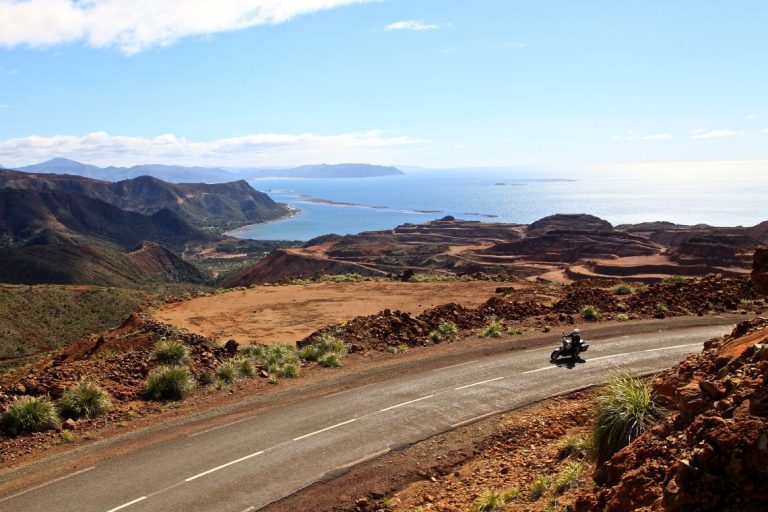For a small island in the Pacific Ocean, New Caledonia offers one hell of a riding experience. Ian Neubauer rides around the Grande Terre.
It’s the afternoon rush hour and I’m filtering through two lanes of traffic flowing slowly out of Noumea, the capital of the French semi-autonomous territory of New Caledonia. Suddenly I see a 4×4 ahead with the word ‘Gendarme’ on its side and make a feeble attempt to stop and snake into a lane. But the rouse is uncalled-for because the coppers move over to give me clear passage through the centre. It’s a fitting metaphor for the friendly and easy-going nature of the French-speaking islanders on this south sea utopia three hours flight from Australia’s east coast.
The weather is balmy, the streets are nice and clean and the roads are as good you’ll find anywhere in the world. The one I’m riding on now, the Voie Express No°2, flows 400km along an inland route parallel to the west coast of the main island of Grande Terre. In French, it means ‘Big Land’, and big it is. There’s a 1,600 metre-high mountain range running right through its centre that I’ll be crossing from west to east and then back again tomorrow. But my current destination is La Foa, a farming community 115km north of Noumea where I’ve booked a homestay for the night.
It’s dark when I arrive at the property. My hosts, Jean and his son Christophe don’t speak much English but it matters not; they’re warm, friendly people who welcome me with a hearty bowl of deer stew.
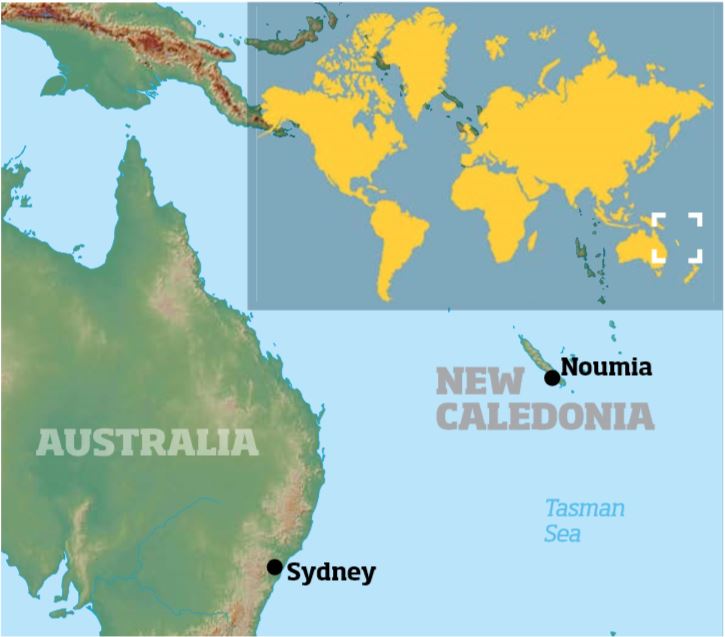
Introduced in 1870, the deer population has exploded to around 120,000 on Grande Terre at the expense of native species whose grasslands the deer destroy. Jean and Christophe are among hundreds of New Caledonians who make it their business to rid the island of them. In broken English, they explain they’re going out hunting after dinner and welcome me to join them.
Christophe is packing a Mauser 66 .375 caliber with telescopic cylinder and interchangeable barrel: enough firepower to stop an elephant in its tracks. His old man’s got a foot-long Maglite to stun the deer plus his faithful dog, a jumpy little Chihuahua called Kitty. But Kitty’s no hunting dog – the damn mutt barks in fright every time one of us steps on a twig. On top of that, the deer stew has given me gas. I shoot off a loud round of farts that would poison any wildlife we cross paths with.
Christophe explains the deer are hard of hearing but have very good eyesight; that it’s the full moon, not Kitty or my exploding butt-crack that are to blame for our lack of luck tonight. After an hour, we call it quits and head back to the homestead for a couple of well-earned beers.
West to east
The next day I awake bright and early, say farewell to my hosts and zoom back out to Highway No°2. Within minutes I come to an intersection that marks the second of five roads that connect Grande Terre’s two coasts. I also catch the welcome sight of two kitted-up bikers standing by a Honda 600 CBF and a formidable-looking BMW R1200R.
I may as well take this opportunity to talk about, or rather confess about, my bike: a Piaggio MP3 300cc three-wheeler I’d borrowed from a mate in Noumea. I’ll admit, the thing kicked ass on the highway, comfortably reaching speeds of 110km/hour with a 40-degree lean tolerance that makes cornering fun. And I love the electronic parking system and handbrake that does away with cumbersome kickstands. But at the end of the day, the Piaggio is a scooter not a bike and there are plenty of places where bikers wouldn’t take you seriously for turning up on one. Luckily, these two guys are cool about it and when I stop to say g’day, they give me a rundown on the road.
“This road is the most beautiful in all of New Caledonia,” says the first bloke, Jean. “At the start, it goes through the forest but at the very top of the range, there’s a barren red landscape that looks like the moon. A little further down from there you’ll come to a great big lookout where you can see for miles over the ocean.”
“Would you like to ride with us?” asks his mate Marc.
We spend the first hour or so careering around switchbacks and sharp bends, climbing higher and higher through thick spruce forests covering the western face of the range. It’s here where the Piaggio which, when I come to think of it looks like a Transformer, shows its lack of breeding. The two-wheel tilting front suspension may give it more grip on smooth surfaces, but on backcountry roads like this they amplify every pothole, subsidence and gravel patch I ride over, and I find myself falling further and further behind the boys.
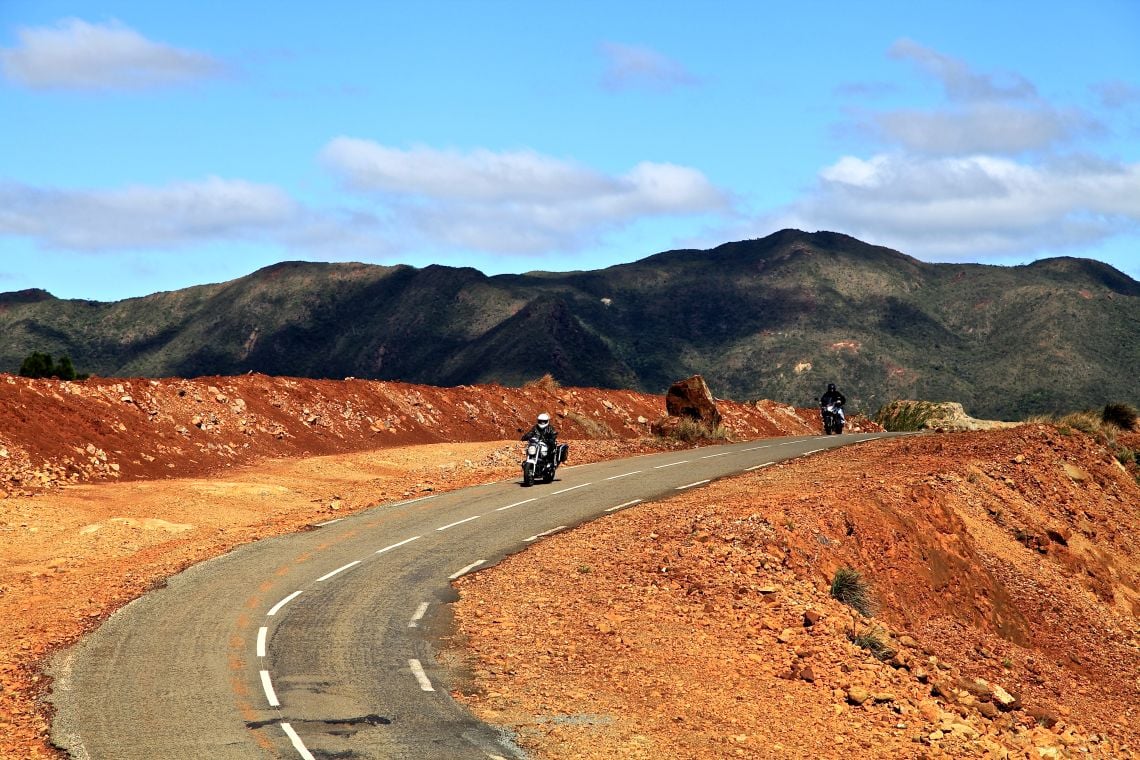
When they stop for a break at the summit, I suggest they ride ahead of me and we meet up again at the viewpoint they told me about. They voice concern about my ability to find it, but with the entire New Caledonian road system downloaded onto my GPS-enabled smartphone, I convince them it won’t be a problem and that I’ll see them later on. After ten minutes riding along a heavily forested ridge, I come to an unmarked left-hand turn the guys had warned me about. It ambles across a wetland plateau with long reedy grass and a massive lake in its centre. I continue riding through a valley carpeted in wildflowers and then into a large bamboo forest where the road thins out into a gravely track. In moments I realise I am inside a Kanak village, the Kanak being the indigenous minority of New Caledonia who now comprise only 40 percent of the population. Unlike Noumea with its wide, clean boulevards, this place is a dump and littered with broken cars. I see a concrete car park overgrown with weeds where a group of Rastafarians are enjoying an early morning piss-up. I don’t feel threatened but neither do I feel welcome. So instead of asking for directions I dig out my phone and open Google Maps, which tells me I’ve missed an unmarked turnoff a few kilometres up the road. You’ve got to love technology.
East to west
After correcting my route I cross a few streams and reach the aforementioned viewpoint. The scenery is epic: I can see a kilometre down the ridge, all the way the coast and way across the Pacific Ocean where the barrier reef that surrounds Grande Terre ebbs and flows like a giant green snake.
The boys are parked at the crest of a hill where they’ve laid out lunch. But this is no ordinary roadside snack, which in my neck of woods usually means crisps, chocolates and squashed sandwiches if you’re lucky. No, this is a Frenchie gourmet picnic with crunchy baguettes, cold meats, cheeses, figs, olives, fruit, chocolate mousse for dessert and even a sneaky little glass of Bourdeaux! I could get used to this kind of stuff.
I take the opportunity to ask the guys if they ever get bored riding around the island.
“I’ve lived in New Caledonia for 30 years and I know just about every road in the country,” says Marc. “But because we’re in the tropics, the landscape can change at any time. You can ride a road in the morning and then do it again in the afternoon, yet the experience can be completely different. So we get a lot of variety.”
With our stomachs full, we begin the dizzying ascent towards the coast. It’s here that I see the lunar-like landscape Jean told me about earlier, slopes layered with mining terraces that have turned the earth rust red in colour. Grande Terre has a quarter of the world’s known reserves of nickel, an ore used in the manufacture of stainless steel. The money earned from its export is the reason New Caledonia is so rich compared to the aid-dependent banana republics it counts among its neighbours. But it’s come at a price. While the landscape here is interesting and makes for stellar photography, I dare say it would’ve looked a lot better before the mining companies ripped it to shreds.
When the descent comes to an end we hit a long stretch of coast which the road clings to like a needy girlfriend.
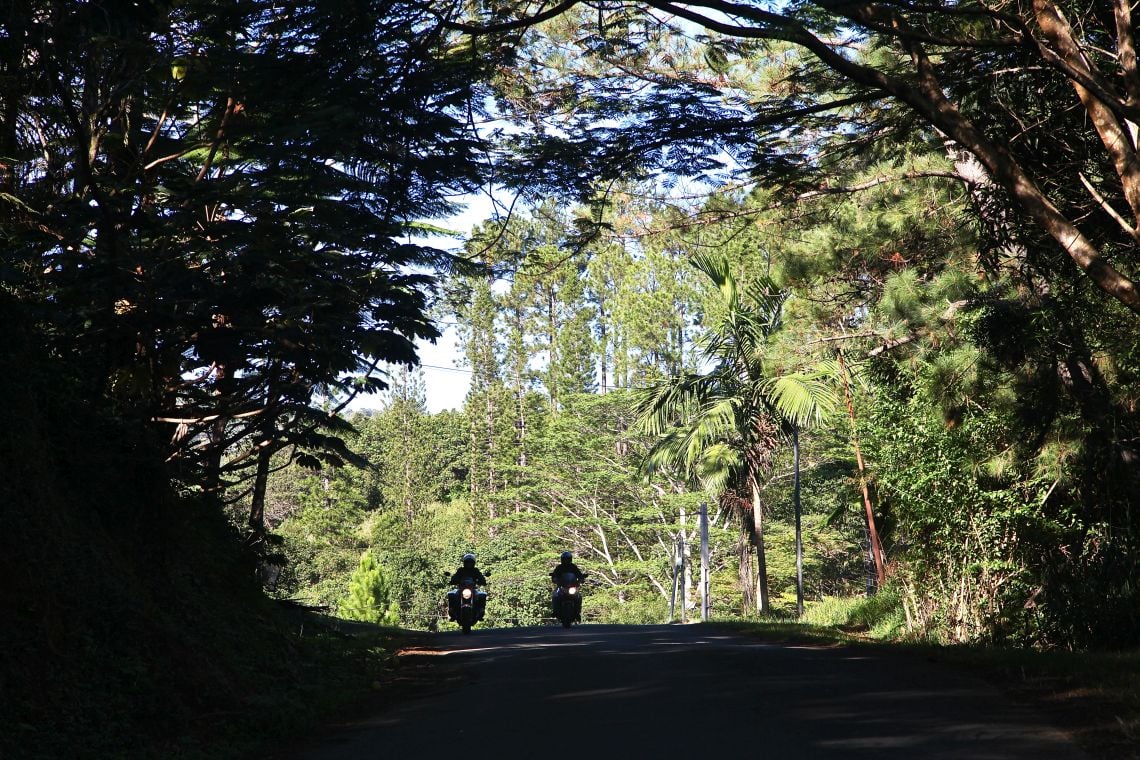
We pass another couple of Kanak villages lined with broken cars and then hit RP6, the next inland road heading back to the west coast. In contrast to the high-altitude crossing we completed in the morning, this road follows a river’s edge at the bottom of a lush green valley spotted with palms. The terrain’s made for fast riding and I have no trouble keeping up with Jean and Marc, and I even ride ahead of them for a while. But when we cross a perfect little wooden bridge that crosses a perfect little rambling stream, I know we’re about to go our separate ways because I need to stop for a swim. They wish me well and ride into the sunset, though I promise to send them a copy of this story when it’s printed.
After a splash in the water, I lay down on the roadside and dry off in the sun. It’s a magical moment in travel and time, just listening to the rambling river and staring at the cloudless sky. From here it’s a quick 30km to the west coast beach town of Bourail, where I’ve booked a room at a guesthouse. But when I get there I can’t find the damn place and spend half an hour riding up and down the main drag to no avail. I try using my smartphone but it gives me no joy, directing me to a random spot on the sand where there’s no guesthouse to speak of.
I have no choice but to park my scooter and knock on the door of a nearby house and ask for directions. No one answers though I hear a bit of a party going in the back garden. When I walk around, I’m approached by a group of guys. They say something to me in French and when I tell them I only speak English, one of them replies in a thick Australian accent. By sheer coincidence, he lives not far from my home in Sydney, and I get invited to join them for a drink. It turns into a round of drinks, a steak on the barbecue and a bit of a party around a bonfire on the beach. It’s a totally awesome night and a sensational end to my ride, and it never would’ve happened if my GPS hadn’t failed me. So next time you’re lost on the road, remember technology is good, but people are far better. Stop and take the time to say g’day.
Three more things to do in New Caledonia
1) Noumea – This smooth seaside city invokes the French Riviera, minus the crime. Take a walk along the coast at Anse Vata Bay, the main tourist hub. Go for a swim on the beach; the water is crystal clear and pollution-free. Then grab a gratin from one of the food vans – a toasted baguette filled with stir-fry beef and french fries and covered with melted cheese. Yum!
2) The Great Lagoon – New Caledonia is surrounded by the largest marine lagoon on earth and the second largest coral reef after Australia’s Great Barrier Reef. Bernard Andreani Snorkelling Treks (+687 779 072; bernard.andreani.nc@gmail.com) offers half-day snorkelling, walking and birdwatching boat tours to Signal Island Marine Park on Noumea’s outskirts for £100 for two people. Bookings essential. Tours depart 8 AM from Noumea’s Kuendu Beach.
3) Surf’s up – Ian’s last stop, Bourail, happens to be New Caledonia’s surfing HQ. If you fancy trying something a bit different you can catch small waves on La Roche Percee Beach, but to really Hang 10, call Manu Hernu of Nekweta Surf Camp (+687 784 026; www.nekweta.com). He’ll take you out on a tender to spot offshore where three – four foot high left-handers break against reefs.
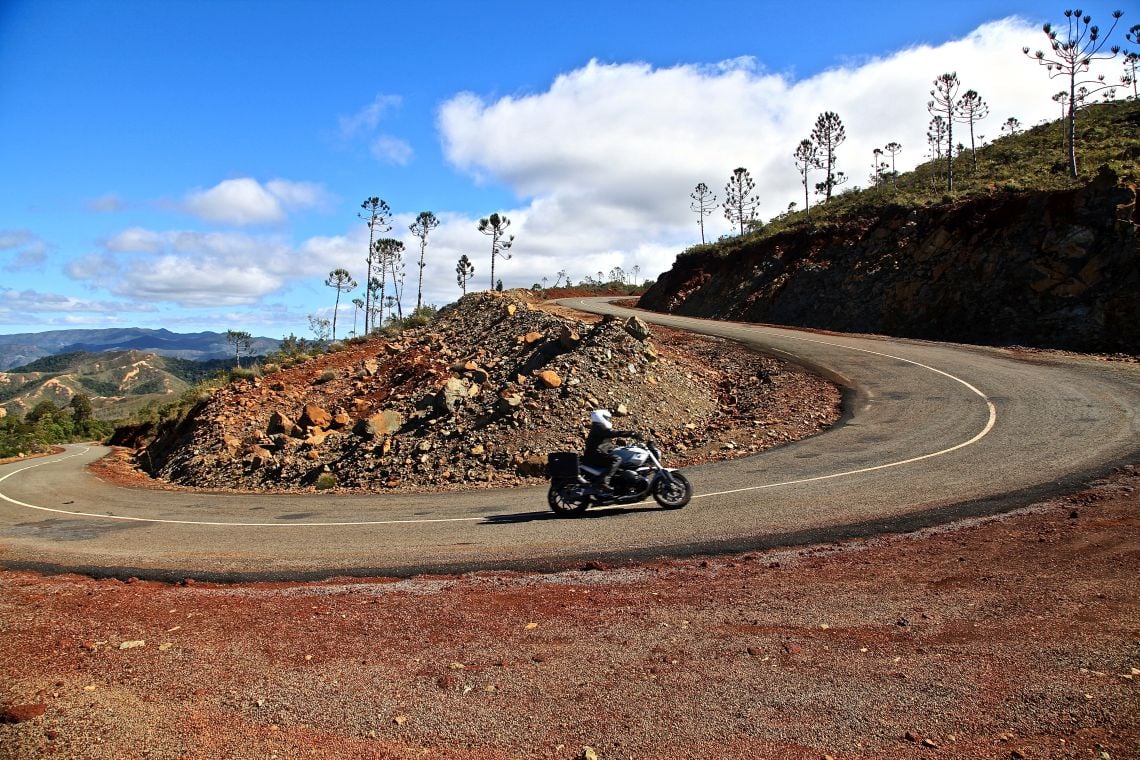
Want to do what Ian did?
Here’s how you can…
Getting there
There are no direct flights from any UK airports to Noumea but you can make the journey by flying via a number of destinations from Finland to Tokyo. Flight times average at about 24 hours (it’s on the other side of the world) and the cheapest way of making the trip is by flying with British Airways and Japan Airways from London Heathrow to Helsinki to Tokyo before catching your final flight to Noumea. This will cost you roughly £1,200 return per person.
Where to stay
Le Meridien (www.starwoodhotels.com) is Noumea’s biggest and best hotel. Balcony suites start from £167 per person per night. Alternatively, check out the Hilton Noumea La Promenade Residences (www.hilton.com) where serviced apartments with ocean views cost roughly £110 per person per night.
Where to eat
Au P’tit Cafe (www.auptitcafe.nc) offers a cracking French-Kanak fusion of cuisine on Avenue des Frères, Noumea, you can grab a brilliant dinner for two here for about £60. Chez Toto is another place to try, it’s traditional French cookery in Noumea’s Latin Quarter. Try the house specialities; foie gras £14 or duck confit £19.
Bike rental
Noumea Rider (www.noumea-rider.lagoon.nc) is New Caledonia’s only motorbike hire company. The owner, Bertrand, rents a fleet of well-maintained Harley Davidsons, BMWs and Ducatis for £160-£220 per day. Tell him Ian from ABR sent you and he’ll take extra special care of you.
How much time to take off work
Factoring in 24 hours flight time from Europe in each direction, two days R&R in the capital Noumea, a four-day bike ride to see all of the island of Grande Terre and two out on the reef, you’ll need at least 10 days to explore New Caledonia.
When to go
New Caledonia enjoys a subtropical climate. It never gets cold and there is no monsoon season, so you can ride there any time of year. The warmest months are November-March.
Riding difficulty
The highways ringing Grande Terre are as good as anything you’ll find back home. The interior roads aren’t that well maintained though, with gravelly corners and potholes. There are plenty of gnarly off-road sections if you’re up for it.
Am I covered?
Every travel insurance premium is different. Many don’t cover you on bikes larger than 150cc, so read the fine print to ensure you’re protected while riding a motorbike with serious displacement.
Petrol prices
While it’s an expensive destination to reach, once you’re there things get a bit cheaper; one litre of petrol will set you back around just £1.
Photos: Ian Neubauer

